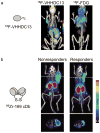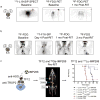Aligning physics and physiology: Engineering antibodies for radionuclide delivery
- PMID: 29537104
- PMCID: PMC6105424
- DOI: 10.1002/jlcr.3622
Aligning physics and physiology: Engineering antibodies for radionuclide delivery
Abstract
The exquisite specificity of antibodies and antibody fragments renders them excellent agents for targeted delivery of radionuclides. Radiolabeled antibodies and fragments have been successfully used for molecular imaging and radioimmunotherapy (RIT) of cell surface targets in oncology and immunology. Protein engineering has been used for antibody humanization essential for clinical applications, as well as optimization of important characteristics including pharmacokinetics, biodistribution, and clearance. Although intact antibodies have high potential as imaging and therapeutic agents, challenges include long circulation time in blood, which leads to later imaging time points post-injection and higher blood absorbed dose that may be disadvantageous for RIT. Using engineered fragments may address these challenges, as size reduction and removal of Fc function decreases serum half-life. Radiolabeled fragments and pretargeting strategies can result in high contrast images within hours to days, and a reduction of RIT toxicity in normal tissues. Additionally, fragments can be engineered to direct hepatic or renal clearance, which may be chosen based on the application and disease setting. This review discusses aligning the physical properties of radionuclides (positron, gamma, beta, alpha, and Auger emitters) with antibodies and fragments and highlights recent advances of engineered antibodies and fragments in preclinical and clinical development for imaging and therapy.
Keywords: ImmunoPET; antibody engineering; antibody fragment; diagnostics; protein scaffold; radioimmunotherapy; radiolabeling; therapeutics.
Copyright © 2018 John Wiley & Sons, Ltd.
Conflict of interest statement
DISCLOSURE OF POTENTIAL CONFLICTS OF INTEREST:
A. Wu has ownership interest in, and is a consultant/advisory board member for ImaginAb, Inc.
Figures





Similar articles
-
High-linear energy transfer (LET) alpha versus low-LET beta emitters in radioimmunotherapy of solid tumors: therapeutic efficacy and dose-limiting toxicity of 213Bi- versus 90Y-labeled CO17-1A Fab' fragments in a human colonic cancer model.Cancer Res. 1999 Jun 1;59(11):2635-43. Cancer Res. 1999. PMID: 10363986
-
Improving the delivery of radionuclides for imaging and therapy of cancer using pretargeting methods.Clin Cancer Res. 2005 Oct 1;11(19 Pt 2):7109s-7121s. doi: 10.1158/1078-0432.CCR-1004-0009. Clin Cancer Res. 2005. PMID: 16203810
-
Targeted Radioimmunotherapy and Theranostics with Alpha Emitters.J Med Imaging Radiat Sci. 2019 Dec;50(4 Suppl 1):S41-S44. doi: 10.1016/j.jmir.2019.07.006. Epub 2019 Aug 23. J Med Imaging Radiat Sci. 2019. PMID: 31451417 Review.
-
Antibody-based Radiopharmaceuticals as Theranostic Agents: An Overview.Curr Med Chem. 2022;29(38):5979-6005. doi: 10.2174/0929867329666220607160559. Curr Med Chem. 2022. PMID: 35674298 Review.
-
Protein targeting constructs in alpha therapy.Curr Radiopharm. 2011 Jul;4(3):197-213. doi: 10.2174/1874471011104030197. Curr Radiopharm. 2011. PMID: 22201709 Review.
Cited by
-
Perspectives on metals-based radioimmunotherapy (RIT): moving forward.Theranostics. 2021 Apr 15;11(13):6293-6314. doi: 10.7150/thno.57177. eCollection 2021. Theranostics. 2021. PMID: 33995659 Free PMC article. Review.
-
GlycoTAIL and FlexiTAIL as Half-Life Extension Modules for Recombinant Antibody Fragments.Molecules. 2022 May 19;27(10):3272. doi: 10.3390/molecules27103272. Molecules. 2022. PMID: 35630749 Free PMC article.
-
Nanobody-Based Theranostic Agents for HER2-Positive Breast Cancer: Radiolabeling Strategies.Int J Mol Sci. 2021 Oct 4;22(19):10745. doi: 10.3390/ijms221910745. Int J Mol Sci. 2021. PMID: 34639086 Free PMC article. Review.
-
Validity of Anti-PSMA ScFvD2B as a Theranostic Tool: A Narrative-Focused Review.Biomedicines. 2021 Dec 10;9(12):1870. doi: 10.3390/biomedicines9121870. Biomedicines. 2021. PMID: 34944686 Free PMC article. Review.
-
Evaluation of Met-Val-Lys as a Renal Brush Border Enzyme-Cleavable Linker to Reduce Kidney Uptake of 68Ga-Labeled DOTA-Conjugated Peptides and Peptidomimetics.Molecules. 2020 Aug 25;25(17):3854. doi: 10.3390/molecules25173854. Molecules. 2020. PMID: 32854201 Free PMC article.
References
Publication types
MeSH terms
Substances
Grants and funding
LinkOut - more resources
Full Text Sources
Other Literature Sources

